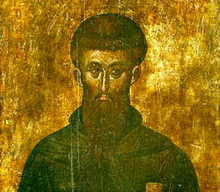Saint Nahum of Ochrid, the Disciple of Sts Cyril and Methodius, Equal of the Apostles
 The feast of St. Naum of Ohrid, the Miracle Worker, is celebrated on July 3rd, to honor the medieval scholar and writer, together with St. Clement, is credited with building upon the work of the sainted brothers Cyril and Methodius to spread Christianity among the Slavic speaking peoples of Europe. Naum is known as the “living saint” for the numerous miracles that are attributed to him even today, centuries after his death in 910, at an age of 80 years.
The feast of St. Naum of Ohrid, the Miracle Worker, is celebrated on July 3rd, to honor the medieval scholar and writer, together with St. Clement, is credited with building upon the work of the sainted brothers Cyril and Methodius to spread Christianity among the Slavic speaking peoples of Europe. Naum is known as the “living saint” for the numerous miracles that are attributed to him even today, centuries after his death in 910, at an age of 80 years.
Saint Naum was the youngest disciples of Ss. Cyril and Methodius and attended the mission to Moravia, as well as numerous other missions across central Europe where he helped distributing Bibles written in old Church Slavonic language, that was instrumental in converting many pagan peoples. Naum worked from the scriptorium in Pliska, and later moved to the scriptorium in Ohrid, where, alongside Saint Clement, he write, preached, taught and led a group of scholars in translating and transcribing the Bible. This is considered the golden age of Ohrid’s medieval cultural era. Between 893 and 900, Saint Naum led the Ohrid scriptorium, and in 900 he became a monk at the monastery of Saint Michael, which was later renamed after himself. The legend of the miracles performed by Saint Naum grew quickly and people from across the region flocked to the monastery to seek his help. The monastery quickly grew, with donations from grateful petitioners, which included the regional loyalty. The monastery is at the exact opposite side of the lake from the church of Saint Clement, and legend has it that the two saints, who are said to have been brothers in some accounts, began work to expand and rebuild their respective shrines, at the same time, even agreeing to ring the bells to notify each other when construction starts. According to the legend, a flock of gulls flew into the rope of the bell of one of the monasteries and made it ring before time, but there are disputed accounts if this regards the monastery of Saint Naum or the church of Saint Clement.
Naum died in 910, but the wonders continued, and soon an annual fair was introduced, initially on January 5th, the day of his death, but later, in the 18th century, to distinguish it from Christmas, the fair was moved to July 3rd.

